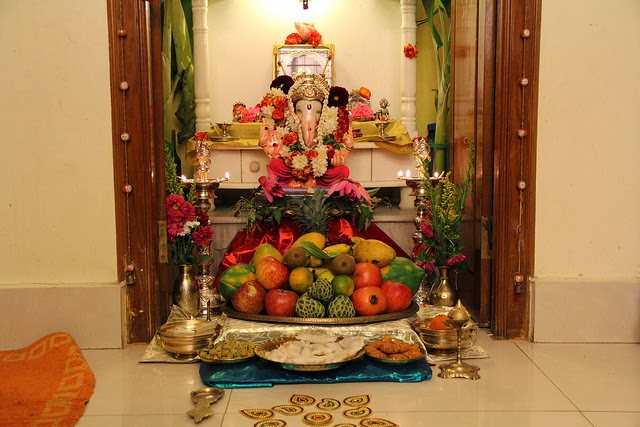Ganesh
Chathurthi is one of the most enthusiastically celebrated festivals in India
But the
fun part of the festival goes well beyond these 11 days, with preparations
beginning as much as two months in advance. Special markets are set up,
colorful goods are displayed and there is a buzz in the air. Amidst all this,
it is easy to get lost and confused, wondering what to buy. So knowing how busy
you are, we’ve created a list of 8 must haves to shop for this Ganesh
Chathurthi. Here we go!
 |
| Source |
1. Decorations – No festival in India
2. Ganesha Idol – To be on the safe side,
most people book their idols a couple of months in advance, in which case you
can ask for customizations. Else, ready made idols are easily available; you
can even buy them online! Be aware of the material the idol is made of. They
are available in plastic, rubber and plaster of Paris, but if you care for the environment,
clay idols are the way to go.
3. Accessories for the Idol – The Ganesha
idol is the central point of this celebration and needs to be decorated too.
It’s best to buy the accessories after you’ve bought the idol, so that they are
in proportion. The idol is usually seated on a pedestal, so get one that fits.
Get beautiful decorative ribbons, colorful scarves or dupattas and flowers. You
can also get jewelry for your idol in shades of gold or silver. Don’t forget
the headgear; you can either choose a crown or mukut, or opt for a turban.
4. Prayer Supplies – If you’re conducting
the prayer from home, you’re going to need all the relevant supplies. Stock up
on incense sticks, camphor, sandalwood paste – plain and red, turmeric, betel
nuts, saffron, ghee and coconuts. Shortly before the actual ceremony, buy mango
leaves, betel leaves, milk, fruit and flowers. You are likely to find
everything at a single store that sells prayer supplies.
5. Lights and Lamps – This is one area
where you can mix and match the modern and the traditional. Lanterns and diyas
are quite popular, along with fairy lights. A tray to hold the smaller lamps is
useful. Take care to check all your electrical settings in advance, so that
your fancy lights don’t literally give you a shock on the main day!
 |
| Source |
6. Sweets – Many homes make their own
sweets for Ganesh Chathurthi, but if you’re not, place orders in advance to
avoid the last minute rush. Popular sweets for Ganesh Chathurthi are besan
laddoos, motichoor laddoos, modaks and barfi. There are now modern variations
like dry fruit and
chocolate modaks, so do your research before buying.
chocolate modaks, so do your research before buying.
7. Groceries
– You can’t just eat sweets the whole time, so you need to prepare for other
meals as well! Stock up on staples like oil, grains and sugar. Check your
festival menu and buy jaggery, lentils, beans, potatoes and vegetables. Make
sure you keep in mind the number of guests, if any.
8. Clothes – Probably the favorite item on
the list for many! Make the most of the End-Of-Season-Sales and online deals;
they offer good discounts on clothes for the entire family. This is also a good
time to buy clothes for the extended family and gifts for friends and relatives
that you don’t see that often. A great opportunity for everyone to flaunt their
traditional wear!
This list
should cover your basics for the festive season. Now that we’ve taken the
stress out of shopping, you can go ahead and enjoy this time to the fullest.
Happy Ganesh Chathurthi!










